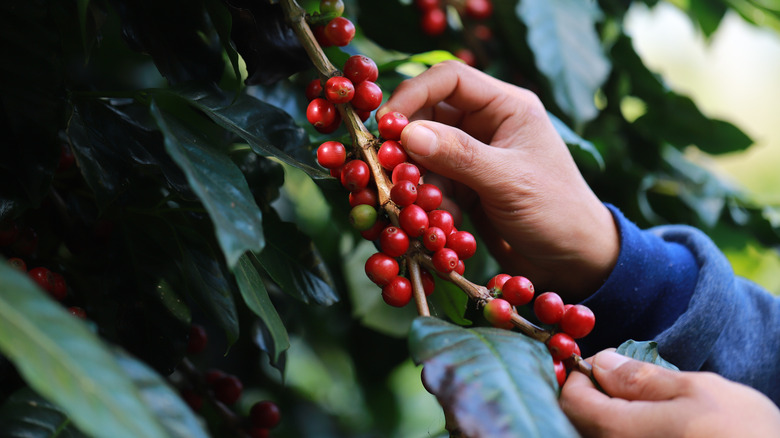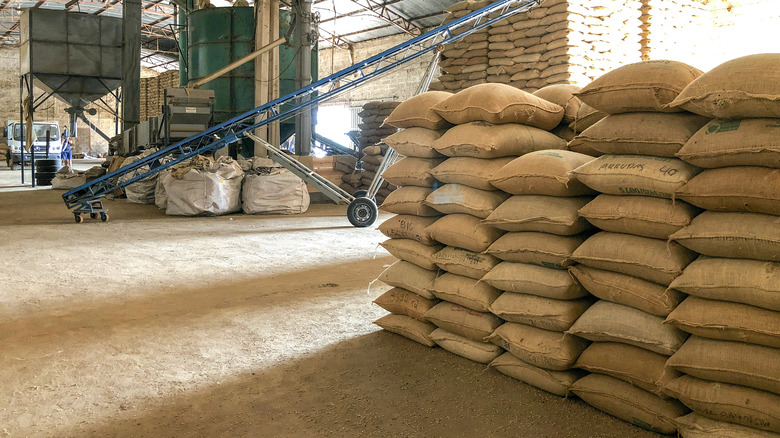Why It Might Be Harder Than Ever To Find Coffee In 2022
Few things give us joy the way coffee does. And while we may be partial to certain coffee brands, roasts, preparation methods, or add-ins from milks to flavored syrups, at the end of the day, the world's coffee supplies rest on the branches of just four types of beans: Arabica, Robusta, Liberica, and Excelsa. And of these four — Arabica and its cousin Robusta stand out as the most common of the coffee bean varieties available in the world today (via District Roasters).
So, how much coffee needs to be grown in order to quench the world's thirst and craving for coffee? Statista says that between 2020 and 2021, coffee growers produced 102.1 million 60-kilo bags (that's just over 132.25 pounds per bag) of Arabica. Add to that, from 2018 to 2019, Robusta production topped about 70 million bags of similar size. And while that seems like plenty of beans in just a few years, we may soon find out exactly how much coffee it takes to power the world, because the world's coffee producers are projected to yield less than 88 million bags between 2021 and 2022.
Coffee prices are higher thanks to weather, transport problems
Like many agricultural commodities including wheat and sugar, how much coffee the world will see depends to a great extent on factors outside of a farmer's control — like the weather. And commodity analysts around the globe are warning of fewer days powered by less, more expensive java ahead, and for a variety of reasons (via Capital.com).
Saxo Bank's head of commodity strategy Ole Hansen says one key driver in the increase in coffee prices is growing conditions in Brazil, whose Arabica crops meet most of the world's coffee needs. "I think we need to focus on what's been unfolding in Brazil this year, where we've had a generational low in temperatures, a very quick spell of frost which hit some of the growing areas, and we've had a period of drought — this has left the 2022 crop in a bit of a precarious state," he explained (via CNBC).
Coffee has also been hit by the same transport constraints which have caused bottlenecks with other grocery items, from paper products to beverages. "While production was relatively unaffected by COVID ... coffee [prices were] directly impacted by the scarcity of container availability in 2021, leading companies to over-purchase in order to guarantee production and sales," per a Rabobank analysis (via Fortune). A combination of supply chain and weather challenges drove coffee prices to highs not seen since 2010.
Not all places will see coffee price hikes
The price hike is unlikely to hurt large-scale coffee sellers like Starbucks, which said last October that it has been able to lock down its coffee prices for the next 14 months, and that any price increases seen by Starbucks loyalists isn't because of a spike in bean prices. Unfortunately, things don't look as rosy for smaller coffee chains and independents. The Wall Street Journal says the famed Cafe du Monde in New Orleans has already had to hike prices by 5%, thanks to the increase in the price of beans and cans.
Coffee analysts are now pinning their projections on weather forecasts to determine what direction bean prices will go next. A La Niña weather pattern could indicate that dry weather conditions could still be on the horizon, making for more thirsty coffee trees and fewer beans as a result. As Brazilian coffee broker Thiago Cazarini told the Journal bluntly, "We haven't seen the highs in coffee yet."


